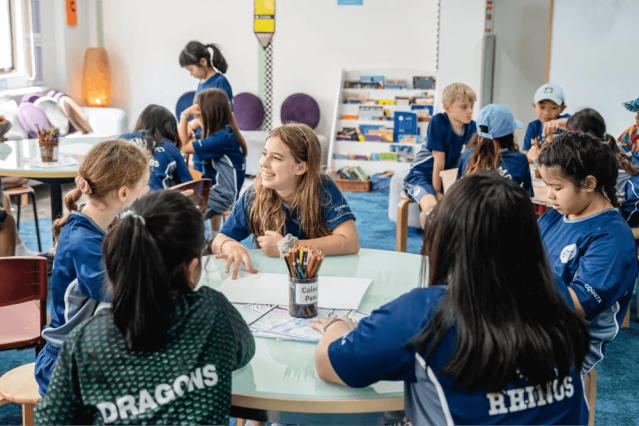Peer Led Learning – Definition, Benefits & Its Application
Peer-led learning is an educational approach where students take on a teaching role to help their peers understand and learn new concepts. This method encourages active participation, collaboration, and shared responsibility for learning among students.
It can take various forms, such as peer tutoring, study groups, collaborative projects, and discussion forums. Peer-led learning promotes deeper understanding, enhances communication skills, and fosters a supportive learning community.
What is Peer Led Learning?
Peer-led learning is a teaching model in which peer support forms an integral part of the learning process. Within peer-led learning courses, educators will encourage students to hold peer-led activities regularly, where the high-performing students provide personal study aid to their peers.

The first major institution to conduct real-life models of peer-led learning was the City College of New York. In an effort to help new students with Chemistry, educators reduced the number of lectures from four hours to three hours. Instead, they replaced the reduced hours with peer-led learning, where high-performers assisted their peers.
The preliminary results were quite positive, with increased student attitudes and performance in Chemistry. This led to further research into the model, and the literature has so far confirmed its effectiveness.
What are the Benefits of Peer-Led Team Learning in Education?
Through a vast body of research, researchers have identified the three key benefits of peer-led team learning in education:
-
- Conceptual Understanding: Peer-led team learning enhances students’ conceptual understanding of difficult subject matters when providing materials designed for group work. Examples of these materials. Leaders are required to familiarize learners with the concepts by dwelling on proper questions.
- Social Anxiety: Peer-led team learning is effective at situational anxiety relief, especially if the subject matter is deemed difficult or boring by the students. If the model is sustained over time, the leading students will become better at supporting others, thus increasing the social anxiety relief effect of the model.
- Problem-Solving Skills: Peer-led team learning encourages students to work with one another to solve problems, which improves their problem-solving skills substantially.
6 Criteria for Effective Peer Led Team Learning
Peer-led team learning (PLTL) offers numerous benefits to students, but only if peer-led activities are organized effectively. In a research paper authored by Gafney, L (Evaluation strategies. The Workshop Project Newsletter–Progressions: Peer-Led Team Learning, 1(2), 5-7), six key criteria that affect peer led learning have been identified.

-
- Integration of PLTL assignments with the total course: Students must first believe in the value of peer-led team learning before they can reap the benefits of this approach. For younger students, educators can accomplish this by adding game elements to PLTL learning.
- PLTL instructor’s involvement: Even though PLTL sessions are led mainly by students, the instructor still plays a crucial role. Instructors should always try to integrate the PLTL elements as seamlessly into the lessons as possible. Furthermore, educators should always try their best to show why PLTL learning is important to students.
- Leader training: The leader plays a key role in conducting successful PLTL activities, so educators should provide initial training to help them embrace the role more effectively.
- Materials: Educators can provide advanced learning materials in the PLTL program, as students will have to work in groups to solve problems. Materials should also be adapted for group work.
- Organizational arrangements: The classroom should be organized to help the students form groups and move around as much as possible. This means that educators should clear all unused furniture and use small chairs as much as possible to avoid friction. A small classroom should be the most useful environment for PLTL learning.
- Institutionalization: The PLTL model should be supported and implemented by an entire institution, not just by individual classrooms. This will enable the institution to provide the necessary resources to sustain resource-intensive PLTL programs. Institutional support also means that educators will be able to assess the effectiveness of the model more accurately.
What Are the Differences Between Peer Led and Traditional Learning?
Peer-led learning is much more dynamic and flexible than traditional learning, which leads to better academic outcomes and student satisfaction.
| Peer Led Learning | Traditional Learning | |
|---|---|---|
| Approach | Collaborative and democratic. All students are equal. | Top-down and rigid. There is a clear distinction between the instructor and students. |
| Course structure | Collaborative exercises with few recitation lessons. | Instructor-led lessons with lots of recitations. |
| Interaction | Collaborative teamwork between team members. | Hierarchical instructor-student interactions. |
| Leadership | Peer leaders guide the activity. | Instructors guide the entire class. |
| Focus | Problem-solving skills and conceptual understanding. | Questions from the students and answers from the instructor. |
| Flexibility | High flexibility with adaptable course materials. | Low flexibility with a rigid learning schedule. |
The table above clearly shows that peer-led learning empowers students to follow their curiosity and be more proactive in their learning process. Educators will also have more free time to provide high-quality care to students equally.
What are the Barriers That Prevent Students from joining PLTL Programs?
In spite of the proven benefits of PLTL programs, students and instructors must still overcome some considerable barriers to successfully integrate PLTL into daily lessons.

Ensure Effective Training
Not everyone is a natural-born leader. Some students might struggle with their position as a group leader, which can decrease the group’s learning effectiveness as a whole. Educators should identify struggling leaders as soon as possible and provide adequate training so that they can tackle the role more effectively.
Standardize Skill Levels for All Students
Every student has a different skill level, and this creates mismatches in PLTL sessions. To overcome this challenge, educators could provide private aid to students who are lagging behind so that they can catch up with their peers.
Measure Learning Effectiveness
Educators should have a structured framework to measure students’ learning effectiveness within and even long after a PLTL program. This will help the institution identify unique challenges and key achievements, enabling it to create better PLTL programs in the future.
Experience Peer Led Learning with ISHCMC
Students at ISHCMC enjoy a diverse environment where they feel safe expressing their ideas and identities. We are a diverse community of people of different nationalities, cultural and educational backgrounds, races, ethnicities, geographies, and socio-economic backgrounds. This diversity helps us appreciate the beauty of difference and develop learning programs that incorporate a diverse group of students.

Let your children become future leaders through our diverse learning programs at ISHCMC! Contact our admission office now for more details.






